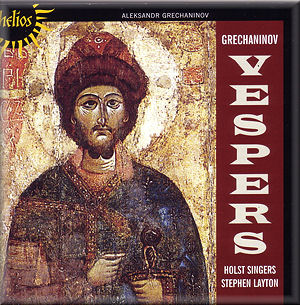 |
 |
|


alternatively
CD: MDT
AmazonUK
AmazonUS
|
Aleksandr
Tikhonovich GRECHANINOV
(1864-1956)
Now the Powers of Heaven, Op 58 No 6 [5:20]
In Thy Kingdom, Op 58 No 3* [7:29]
Lord, now lettest Thou Thy Servant, Op 34 No 1 [2:32]
All-Night Vigil, Op 59 (Vsenoshchnoye bdeniye) ('Vespers') (1912)
[47:12]
 Holst Singers/Stephen Layton
Holst Singers/Stephen Layton
* James Bowman (counter-tenor)
rec. 8, 9, 15 November 1998, The Temple Church, London.
 HYPERION HELIOS CDH55353 [63:16]
HYPERION HELIOS CDH55353 [63:16] 
|
|
|
I remember vividly the first time I heard Grechaninov’s liturgical
music. That was back in 1994 when Chandos issued their superb
recording of the Seven Days of Passion. The opening track floored
me and to this day I know of no more beautiful and impressive
sound as sound per se than a fine echt Russian choir
in full voice. Somehow this remarkable disc, first issued on
Hyperion passed me by; its re-release on their budget label,
Helios is very welcome. It could alert collectors to the hitherto
unknown glories of a Russian orthodox choral tradition which
dates back little more than a hundred years but has its roots
in chants centuries old.
As a prelude to the main work, we are given three other pieces:
two motets and a responsorial canticle, the latter featuring
counter-tenor James Bowman, who has long been involved as a
solo performer with the Holst Singers. His role here requires
him to sing within a range of no more than five notes but he
does so expressively.
If you are already familiar with, and love, the sonorous incantation
of Rachmaninov’s so-called “Vespers”, this disc is definitely
for you. Regardless of the specific qualities of the music,
just the sound of the choir here is sufficient to transport
me into a spiritual dimension redolent of bejewelled icons,
smoky tapers and the practice of unshakable faith through centuries
of tumult and oppression. This may be a Romantic fantasy, but
the music itself consistently reaches heavenward. The most striking
aspect of the scoring in this work is the frequency with which
the basses are required to sustain an ostinato underpinning
the great blocks of four-part choral writing. These features
in combination with the glorious harmonic melismata and soaring
sopranos of exceptional purity and homogeneity create one of
the most evocative and distinctive musical idioms I know. The
music spans four octaves, from an incredible repeated low A
from the basses to the plangent top line and rarely strays from
noble major keys, creating a sense of luminosity. Sample the
sustained low Bs at the end of track 2 and the low A which concludes
track 12, and ask yourself if the choir in question can really
be English and ostensibly amateur – yet it is; the first I have
heard to match the choirs under Sveshnikov in the famous 1965
recording of the Rachmaninov “Vespers” or the Novospassky Monastery
Choir in a superb 1994 “Russian Chant for Vespers” disc on Naxos.
The Holst Singers are the most authentically non-Russian, Russian–sounding
choir I have ever heard – and their Russian pronunciation sounds
excellent, too.
The highlight of this disc is track 12; a grand, complex, multi-voiced
hymn of praise in which choral recitative alternates with solo
fragments in the style of a liturgical reading. The next, final
track, Vzbrannoy voyevode, brings the work to a fitting,
climactic conclusion by imitating the swinging of great bells
in hymning the Mother of God. There is a kind of monumental
simplicity to Grechaninov’s stately melodies; the work is a
paradigm of 19th Century Russian polyphony.
It was Tchaikovsky who first introduced a choral cycle for the
Vigil in 1881. The first performance of Grechaninov’s “Vespers”
in 1912 predates Rachmaninov’s celebrated version by three years
yet it soon declined into desuetude and was not performed again
in modern times until 1995 in the United States. Despite the
relatively few texts set and its comparative brevity at 47 minutes
– possibly an indication that the composer envisaged performance
of his music in concert more than as integral to liturgical
worship - it creates a sense of massive assurance as it weaves
fragments of traditional chant into richly textured waves of
sound. Given that it offers Grechaninov’s individuality of style
but also many of the virtues of Rachmaninov’s - admittedly more
substantial - version, it deserves to be far better known.
This is a bargain issue but full notes and texts are provided.
Ralph Moore
|
|

